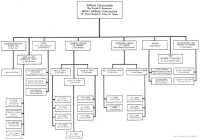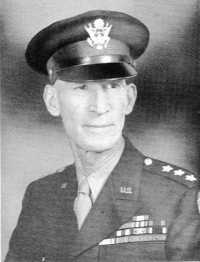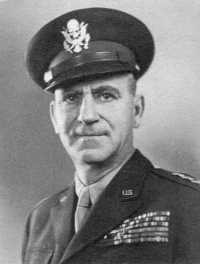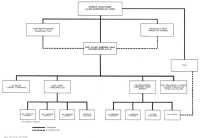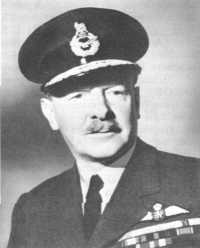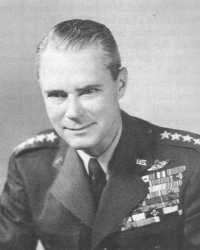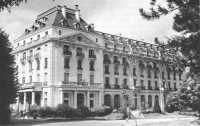Chapter 15: Command Reorganization, June–October 1944
A number of changes in command arrangements affecting the Allied Expeditionary Force marked the period between the invasion of Normandy and the entry into Germany. These included the Supreme Commander’s assumption of direct control of the forces in the field, the activation of new army group headquarters, the shifting of four additional armies to the Continent, the clarification of relations between SHAEF and U.S. theater staffs, and the reorganization of strategic and tactical air commands. (Chart 5)
The Ground Forces
General Eisenhower Takes Command
The Normandy invasion began under an arrangement by which General Montgomery was to command the ground assault forces until such time as the Supreme Commander should take personal control of operations in the field. The date of change-over was to be determined in part by the build-up of U.S. forces on the Continent; no shift appeared necessary so long as only one U.S. army was ashore. When, however, a second U.S. army should be .required, the Supreme Commander proposed to bring forward a U.S. army group to coordinate the actions of the two U.S. armies. He would then decide the point at which he should take over the task of coordinating the British and U.S. army groups.1
The Third U.S. Army, brought from the United States and put under the command of General Patton in late 1943, remained in England during the first weeks of the invasion while some of its divisions were sent to the Continent for initial use in the First Army. The plan for the breakout from the Cotentin peninsula required the employment of some of these units. At the opening of the attack on 25 July, General Eisenhower announced that, on a date set by General Bradley, the U.S. forces on the Continent were to be regrouped under the 12th Army Group.2 An additional statement to the effect that U.S. assault forces were to remain under General Montgomery until General Eisenhower allocated a specific area of responsibility for
Chart 5: Operational chain of command, AEF, 1 September 1944
the U.S. army group immediately led to some confusion in the press.3 Although the 12th Army Group became active on the Continent on 1 August and Montgomery channeled his orders to the U.S. armies through it, the 21 Army Group commander retained over-all control until 1 September.
This arrangement was valuable in that it permitted one commander to coordinate Allied forces during the period of the breakout and pursuit. But it led many people in Great Britain and the United States to overestimate the degree to which General Bradley’s army group was subordinated to General Montgomery. Throughout August, General Montgomery continued as before to issue operational instructions to the U.S. forces, but he consulted General Bradley increasingly as a partner instead of a subordinate and gave him great latitude in directing the U.S. forces. General Bradley presented some of his plans directly to General Eisenhower. The difference in the command relationship which existed between the 21 Army Group and the U.S. forces in June and July and the arrangement in effect in August was largely that between the direction of an operation and the coordination of a joint effort.4
On the day General Bradley assumed command of 12th Army Group on the Continent, the Third U.S. Army became operational. The enemy was aware almost immediately that General Patton was in action and announced the news to the world, although the Allied press was forbidden to print any notice of the fact. Some of General Patron’s subordinates criticized the ban severely, charging SHAEF with jealousy of their chief. SHAEF had explained its reason for this action in the memorandum of 25 July on command reorganization. Desiring to continue the threat against the Pas-de-Calais based on the suggestion that General Patton had an army group in the United Kingdom poised for an attack, SHAEF asked that the Third Army commander’s presence on the Continent be kept secret until it was certain that the Germans had positively identified him. Since a common trick of the enemy was to announce the arrival of new units in the hope of getting a confirmation or denial, SHAEF waited several days before making a statement. When it did come, without any explanation of the reason for secrecy, the feeling was heightened that Supreme Headquarters had some ulterior reason for its silence.5
Scarcely had criticism of SHAEF’s handling of the Patton story subsided when a greater uproar arose over the announcement of the activation of the new U.S. army group. In mid-August, as a result of a censor’s error, press correspondents were allowed to announce that 12th Army Group had been activated and that General Bradley was now equal in authority with General Montgomery. Since the latter statement would not become true until General Eisenhower assumed direct command in the field, an arrangement scheduled for 1 September, SHAEF officials denied the statement without adding that the change would be made within a short time. Some London papers,
unaware of the projected command arrangements, sharply attacked the original statement, asking that persons responsible for it be punished and that an apology be made to General Montgomery. In the United States some newspapers lashed out at the command arrangements in Europe saying that British officers had been given the posts of ground, air, and naval commanders, thus reducing General Eisenhower to the role of figurehead. Fearing that this criticism would spread and be injected into Congressional debate, General Marshall wrote General Eisenhower that “The Secretary [Mr. Stimson] and I and apparently all Americans” were strongly of the opinion that it was time for the Supreme Commander to take direct command—at least of the U.S. forces. To this recommendation, already made by Tedder and Smith, General Marshall added: “The astonishing success of the campaign up to the present moment has evoked emphatic expression of confidence in you and Bradley. The late announcement I have just referred to has cast a damper on the public enthusiasm.”6
General Eisenhower was startled by the reaction and indicated that General Bradley shared his feelings. Apparently irritated, he replied: “It seems that so far as the press and public are concerned a resounding victory is not sufficient; the question of ‘how’ is equally important.” It would be a great pity, he agreed, if General Bradley were denied full credit for his brilliant work “merely because general instructions and policies he has pursued have been channeled through Montgomery.” The current command arrangement, he noted, had been adopted because it was impossible to move Supreme Headquarters to the Continent until an adequate communications network could be secured to connect the United Kingdom and the Continent. While waiting for this development, General Eisenhower added, he had found it necessary to make one person responsible for the temporary control of ground forces in Normandy and had chosen General Montgomery on the basis of seniority and experience. In carrying out that task, the British commander had worked always under plans approved by the Supreme Commander, who made his influence felt by frequent visits to the battlefront. By 19 August, General Eisenhower was inclined to agree with the U.S. Chief of Staff that the time for a change was near at hand, and he hoped that the establishment of new communications would make possible the move of SHAEF to the Continent on 1 September. Even in the absence of such direct control, the Supreme Commander still felt justified in saying, “No major effort takes place in this Theater by ground, sea or air except with my approval and no one in the Allied Command presumes to question my supreme authority and responsibility for the whole campaign.”7
Anticipating his assumption of direct control in the field, General Eisenhower had sent his headquarters commandant and the chief of the Signal Division to the Continent in early August to find a site which would have adequate communications for Supreme Headquarters. Toward the end of August, they decided that Jullouville, a small town just south of Granville at the base of the Cotentin peninsula,
General Simpson (photograph taken in 1945)
would serve. With this assurance, the Supreme Commander announced that he would assume direct operational control on 1 September with General Montgomery and General Bradley as respective commanders of the Northern and Central Groups of Armies.8
SHAEF became operational on the Continent on 1 September at Jullouville. Its forces, now consisting of two army groups (21 and 12th) and four armies, were soon augmented by another army group and three armies. One of these armies, the Ninth, which had been brought to the United Kingdom shortly before the invasion, became operational under Lt. Gen. William H. Simpson on 5 September 1944 and was assigned to the 12th Army Group. On that date General Simpson took command of all forces in the Brittany peninsula which had been operating there under General Patton’s command.9 The other units, which were even then engaged in the battle for southern France, were shortly to be incorporated into General Eisenhower’s command as the 6th Army Group.
Command of ANVIL/DRAGOON Forces
General Eisenhower had assumed before D Day that one U.S. and one British army group would be sufficient to control Allied forces on the Continent. He did not object, however, in July 1944 when the War Department suggested that the 6th Army Group be created to command the Allied forces that would land in the south of France. Both the War Department and Headquarters, North African Theater of Operations (NATOUSA), emphasized that this additional army group was needed to coordinate civil affairs and to assure U.S. control of the operation. The Supreme Commander also agreed to the selection of General Devers for the 6th Army Group post. To dispel a rumor that he was opposed to the appointment, he cabled Washington that, while he did not know General Devers well, all reports were that he was doing a fine job and had the faculty of inspiring troops.10
General Wilson, Supreme Commander in the Mediterranean, and General Eisenhower agreed before the landings in southern France that troops put ashore in that
area would ultimately be placed under SHAEF, but probably not until they had advanced in strength north of Lyon. Before that time General Eisenhower was to keep General Wilson informed of his scheme of action in order that the Mediterranean commander’s campaign would conform to OVERLORD operations. SHAEF was not ready to take over the maintenance of the 6th Army Group immediately; reserve stocks of supplies in the Mediterranean could be used for some weeks to support the forces in southern France. General Eisenhower also proposed that Allied Force Headquarters retain responsibility for civil affairs in the south of France as long as that headquarters continued to supply the ANVIL/DRAGOON forces. These suggestions were accepted by General Wilson.11
The rapid advance of the ANVIL armies from the south and the sweep of the forces to the east in the opening days of September hastened SHAEF’s assumption of the operational control of units coming from the south. At 0001, 15 September, in accordance with the order of the Combined Chiefs of Staff, the 6th Army Group became operational under the command of General Devers. It and the First French and Seventh U.S. Armies passed from Allied Force Headquarters to SHAEF. The Twelfth Air Force handed over the XII Tactical Air Command to the Ninth Air Force. For the moment, Allied Force Headquarters retained responsibility for the administration, logistical support, and maintenance of ANVIL/DRAGOON forces and civil affairs in the south of France.12
General Gerow (photograph taken in 1948)
Fifteenth Army
Before the second U.S. army was committed in Normandy, the War Department made plans to activate a fifth U.S. army, the Fifteenth, which was ultimately to be added to the forces under the Supreme Commander’s control. The army was activated at Fort Sam Houston, Tex., in August 1944. It began operations in the United Kingdom in late November of the same year. Toward the end of December the unit began moving to the Continent where it became operational on 6 January 1945. Ten days later General Gerow, commander
of V Corps, took command of the new army.13
SHAEF, ETOUSA, and Communications Zone in 1944
General Eisenhower’s dual role of Supreme Commander and U.S. theater commander was accompanied by some complications in the handling of U.S. administrative and supply matters on the Continent in 1944–45. Basically the difficulty arose because General Eisenhower did not wish to set up a separate theater administrative staff. He realized that there existed a shortage of qualified staff officers and that it was necessary if possible to avoid establishing an additional staff. He tended frequently, therefore, to call upon U.S. members of the SHAEF G-4 Division as well as members of Headquarters, Communications Zone, for advice in administration and supply matters.14
In mid-January 1944, General Eisenhower had consolidated Headquarters, European Theater of Operations, U.S. Army, which was responsible for all U.S. forces in the theater, and Headquarters, Services of Supply, which had the chief responsibility for mounting and supplying the U.S. part of the operation. At the same time he appointed Maj. Gen. John C. H. Lee, the Services of Supply commander, as deputy theater commander with special responsibilities for administration and supply. General Lee’s tasks included command of the Communications Zone troops in the United Kingdom and on the Continent, necessary activities in connection with static defense, and performance of additional duties delegated by the theater commander.15
Several problems soon developed out of the new arrangements. Combat commanders did not like the fact that the chief of the services of supply was in a position to control the inflow of reinforcements and supplies in such a way as to discriminate against the field forces. Since there was no other U.S. headquarters to act as an umpire, the U.S. members of the G-4 Division, SHAEF, sometimes found themselves acting as General Eisenhower’s advisers in these matters. General Lee and his staff felt that the SHAEF G-4, General Crawford, was attempting to control all U.S. supply matters. Shortly before D Day, General Lee asked for a clarification of the whole command relationship. On D Day, General Smith drafted an order saying that General Eisenhower would use U.S. members of the SHAEF staff only in those purely U.S. matters which remained under his direct control.16
General Eisenhower found that he had to intervene personally in the matter in early June and again in mid-July. On the latter occasion, he emphasized that the determination of broad policies, objectives, and priorities affecting two or more major U.S. commands was the responsibility of the U.S. theater commander. He proposed to delegate part of these duties to the major commands-12th Army Group, Communications Zone, and USSTAF. General Eisenhower stipulated, however, that as theater commander he would utilize both the U.S. elements of the SHAEF staff and the chiefs of special and
technical services of ETOUSA for advice.17
In order that no question should remain in the minds of his staff members, General Eisenhower on 21 July laid down the procedure for carrying out “so-called American administration in this Allied theater of operations.” Communications with various U.S. headquarters on supply were to be channeled through the Communications Zone commander, since he retained all theater duties except decisions and policy on major differences among the principal U.S. commands. Because it was clearly impossible to separate U.S. and Allied matters completely, General Eisenhower added, he would habitually use “the senior U.S. officer in each of our several sections as an advisor on applicable U.S. matters, when the subject is of the type that requires the Theater Commander to take personal action.” Although this arrangement, he noted, did not make SHAEF officers part of the theater staff, they were “convenient agents responsible to me for advice and where necessary, for following up something of particular importance.”18
The new system failed to satisfy either the Communications Zone or SHAEF G-4 staffs. The former felt that the situation was unsatisfactory in that it separated the theater commander from his staff, required the expansion of U.S. personnel at SHAEF to handle supply matters, and weakened the position of Communications Zone relative to other U.S. commands in Europe which tended to look to SHAEF in administrative matters. Army group and army commanders were likewise dissatisfied with the arrangements of mid-July. The supply problems that developed in late August and early September, particularly the ammunition and gasoline shortages, led to strong criticism of Headquarters, Communications Zone. As a result, General Crawford, the SHAEF G-4, in mid-September asked that the U.S. members of the SHAEF staff be given “a considerably greater measure of supervision than [seemed] to be contemplated by existing orders.” He did not mean that General Lee’s staff should cease to function, but held that increased supervision by SHAEF was required in such matters as speeding up ammunition for U.S. units in the Brest peninsula, shifting U.S. supplies to the 21 Army Group, and allocating rolling stock. An alternative solution, he added, was to attach strong elements of Communications Zone to SHAEF to act directly under the Supreme Commander.19 General Eisenhower did not take action on these proposals, and the same general organization continued to exist until the end of 1944. While the administrative system was marked by friction, its functioning was assured by the fact that Generals Eisenhower and Smith were sufficiently near Communications Zone to make sure that difficulties were held to a minimum and that their operational decisions were promptly implemented.
The Air and Naval Forces
Formation of the First Allied Airborne Army
The establishment of the First Allied Airborne Army under SHAEF to coordinate the varied elements of air and ground forces essential for airborne operations on the Continent was one of the major command changes of 1944. Such coordination proved necessary because parachute and glider troops used in the airborne operations were part of the ground force organization, while the aircraft which carried the troops, furnished escorts, and resupplied the airborne units were under air force command. The problem became further complicated when both British and U.S. air and ground forces were involved. To simplify the command difficulties and make possible the thorough exploitation of airborne forces, the First Allied Airborne Army was created. (Chart 6)
Back of the formation of a special army headquarters to plan and carry out airborne operations was the campaign of the War Department for greater strategic use of airborne forces. Since February 1944, Generals Marshall and Arnold had reiterated to the Supreme Commander the importance of strategic employment of these units. General Eisenhower agreed with their views in principle, but, as has been observed, doubted the feasibility of using them strategically in the opening phases of the assault when it would be difficult if not impossible to open lines of communications to them. As the War Department continued to press for a strategic airborne operation using up to six divisions, it became evident that an airborne headquarters which could plan and execute such activities was necessary. On 20 May 1944, SHAEF set the period between 12 and 26 June as the time for the activation of such an organization. Two weeks later, SHAEF asked AEAF and the army groups for their reactions to a plan b.y which airborne divisions and necessary air forces would be brought under one organization for planning, command, and coordination. The 21 Army Group approved but asked that the activation be postponed until SHAEF assumed operational command of the ground forces. The U.S. army group disapproved on the ground that United States airborne troops should be controlled by a U.S. rather than an Allied command. On 20 June, General Eisenhower approved the organization of a combined United States-British Airborne Troop Command, established as a modified corps headquarters under a U.S. Army Air Forces officer with the rank of lieutenant general. The new headquarters was to be activated about the time SHAEF became operational on the Continent.20
In explaining his action to General Marshall, General Eisenhower declared that it was necessary because a suitable agency was lacking for joint planning between the troop carrier command and the airborne divisions. The airborne commander, he said, would be able to assume such responsibilities as joint training, development of operational projects, and logistical support of airborne operations until these functions could be taken over by normal agencies. If an airborne attack by two or three divisions took place in a
Chart 6: Operational Channels, First Allied Airborne Army, 28 November 1944
single area, a temporary corps commander would be designated to conduct the fighting on the ground. He would operate under directives from the airborne headquarters until he joined the nearest army, which would then take operational and logistical responsibility for his units.21 No persuasion seemed to be necessary so far as the U.S. Chief of Staff was concerned if one may judge by the Ninth Air Force commander’s remark of mid-July that he knew “General Marshall had insisted on the creation of an airborne army.”22
In mid-July both the AEAF and the Ninth Air Force commanders proposed changes in the airborne command scheme. Lt. Gen. Lewis H. Brereton, the Ninth Air Force chief, felt he should be given responsibility for airborne operations inasmuch as the major airborne troop carrier forces were American. The AEAF commander, Air Chief Marshal Leigh-Mallory, proposed that U.S. airborne forces be placed under a special corps commander and that both U.S. and British airborne troops be unified under one command. At the same time, he wished to limit the latter command to control of the ground forces, while reserving for AEAF responsibility for all air aspects of airborne operations.23
SHAEF replied with the reminder that General Eisenhower had studied the airborne problem for more than one and one-half years and that he felt the proposed reorganization the proper one. On 8 August, Supreme Headquarters announced the establishment of Combined Airborne Headquarters, and eight days later, at the suggestion of its new commander, it was renamed the First Allied Airborne Army. General Brereton was appointed chief of the new headquarters, and Lt. Gen. F.A. M. Browning, commander of the British Airborne Corps, was named his deputy.24 Placed under the new army were IX Troop Carrier Command, XVIII U.S. Corps (Airborne) headquarters, British Airborne Troops, including 1st Polish Parachute Brigade, and the Combined Air Transport Operations Room (CATOR). Royal Air Force Transport and Troop Carrier formations were placed under First Allied Airborne Army only when specifically allocated.25
At the request of AEAF, Supreme Headquarters announced on 18 August that the First Allied Airborne Army would control its own airlift, but that AEAF would retain the responsibility for supporting air operations. In September, the functions of General Brereton’s command were further limited by an agreement that the First Allied Airborne Army would confine itself to outline planning and to operational command. Headquarters, Airborne Troops, though under the operational command of General Brereton, was
Air Chief Marshal Harris
to have direct access to 21 Army Group or the War Office for administrative purposes. Air-transported formations were to remain under the command of ground formations concerned, being placed under the command of Headquarters, Airborne Troops, when necessary.26
Strategic Bomber Command
Among the command shifts of September, one of the most important was that involving the strategic air forces. This was made in accordance with the agreement of mid-April 1944 by which the Supreme Commander had assumed control of the strategic air forces supporting OVERLORD operations. It was clearly understood that, after the Allied forces had established themselves on the Continent, the Combined Chiefs of Staff would review the initial directive for the employment of the bomber forces and the method of their employment.27 At the beginning of September, General Eisenhower was informed that changes in the air command arrangement would be made at the Combined Chiefs of Staff conference shortly to be held in Quebec. The Supreme Commander promptly urged that existing arrangements be continued. He recalled that the basic conception underlying the campaign was the possession of an overpowering air force which made feasible an otherwise
General Vandenberg (photograph taken in 1950)
impossible campaign. The air forces had lived up to expectations, virtually destroying the German Air Force, disrupting enemy communications, neutralizing beach defenses, aiding the ground forces to break through enemy lines, and fulfilling all other demands made on them. Meanwhile, the strategic air forces had been committed to the greatest extent possible on strategic targets and had prevented substantial rehabilitation of enemy industry and oil production. At present the ground forces were almost beyond the range of medium bombers, and in emergencies would require heavy bomber support. General Eisenhower said that he believed this emergency type of aid depended on the continuation of the existing command system. He added that General Spaatz shared his views on the existing system.28
At the Quebec meeting in mid-September, the Combined Chiefs of Staff ultimately decided that considerations in addition to those advanced by the Supreme Commander had to be taken into account. They concluded on 14 September that the Chief of the Air Staff, Royal Air Force (Portal), and the Commanding General, U.S. Army Air Forces (Arnold), should exercise control of all strategic bomber forces in Europe. The Deputy Chief of the Air Staff, RAF (Air Marshal Sir Norman H. Bottomley), and the Commanding General, United States Strategic Air Forces (Spaatz), were to provide control and local coordination through consultation.29
A new directive for the strategic air forces issued at this time undertook to insure continuation of a broad strategic bombing program as well as adequate bomber support for General Eisenhower’s ground operations. The over-all mission of the strategic air forces remained “the progressive destruction and dislocation of the German military, industrial and economic systems and the direct support of Land and Naval forces.” The Supreme Commander’s calls for aid in battle were to be filled promptly. The Combined Chiefs of Staff were to prescribe attacks in support of the Soviet ground forces.30 The strategic air forces were to coordinate their activities with the operations of the tactical air forces, consulting as necessary the AEAF commander, who would normally coordinate air action in accordance with ground force requirements. In a list of priorities worked out by the strategic air force commanders in consultation with Air Chief Marshal Tedder, first priority for strategic bombing was given to the destruction of the petroleum industry with special emphasis on gasoline. Second priority targets were the German rail and water transportation systems, tank production plants and depots and ordnance depots, and motor transport production plants and depots.31
While General Eisenhower would have
preferred complete control of strategic air forces at SHAEF, he told General Marshall that the new arrangement would be satisfactory because of the “goodwill of the individuals concerned” and the assurances that his operations would be supported. He knew he could depend on the backing of General Spaatz, and he had found that Air Chief Marshal Harris was one of the most effective and cooperative members of the Allied team. The Supreme Commander added that the British bomber commander had not only met every request but had led the way in finding new ways and means for particular types of planes to be of use on the battlefield.32
Allied Expeditionary Air Force
Less than a month after the shift in the strategic air forces command, Air Chief Marshal Leigh-Mallory was appointed to command the Allied air forces in southeastern Asia, and the Allied Expeditionary Air Force was abolished, In September 1944, Admiral Lord Louis Mountbatten had sounded out General Eisenhower on the possibility of getting the AEAF chief released to head up the Southeast Asia air command. General Arnold opposed this shift on the ground that a U.S. and not a British airman should be named to the post. At the same time, the U.S. air chief was strongly in favor of abolishing Headquarters, Allied Expeditionary Air Force, which he felt no longer served any useful purpose. He found, however, that the chief difficulty in getting the headquarters abolished lay in finding a suitable appointment for Leigh-Mallory. General Eisenhower, when informed of this situation, cabled General Arnold:
Under present circumstances I agree we could get along without Leigh-Mallory’s Headquarters. The fact is, however, that through every day of this campaign Leigh-Mallory has proved his intense desire to cooperate and a very admirable grasp of the whole situation. Our plans for reorganization when and if he is detached will eliminate that headquarters and all the functions it has been performing will be centered right here at SHAEF. But you should not be under any misapprehension as to Leigh-Mallory’s qualifications and attitude. Admitting that upon first glance he seems to be a bit difficult, he is one of the type that never ceases to develop and above all, he is a real fighter, which I like. He is an experienced and valuable officer.
There is no need to manufacture a job merely to get rid of Leigh-Mallory but on the other hand, as I explained above, if he is taken out of here for any reason I will not assign another man to his present title.
The initiative for Leigh-Mallory’s eventual release came from the British Air Ministry. On 20 September, Sir Archibald Sinclair, Secretary of State for Air, pointed to decisions which had been made at Quebec relative to southeastern Asia and added that Air Chief Marshal Leigh-Mallory should go out to head the Allied air forces there as soon as possible. General Eisenhower asked for a delay until 10 or 15 October inasmuch as Leigh-Mallory was intimately mixed up with the heavy fighting then in progress.33
Allied Expeditionary Air Force was dissolved at 0001, 15 October 1944, shortly after Air Chief Marshal Leigh-Mallory
left for his new post.34 SHAEF Air Staff was then set up under a Chief of Staff (Air), Air Vice Marshal Robb, then serving as SHAEF Deputy Chief of Staff (Air), to absorb the operational functions of AEAF and reallocate its responsibilities. Air Chief Marshal Tedder was assigned the tasks of coordinating the Allied tactical air forces and of stating the Supreme Commander’s requirements for strategic bombing. Administrative functions previously exercised over Royal Air Forces by the AEAF commander were now given to the commander of 2nd Tactical Air Force, while similar administrative control of U.S. forces remained in the hands of the USSTAF commander.35
Allied Naval Forces
The main task of the Allied naval forces under SHAEF was completed once the invading units in southern France had linked up with the troops from the OVERLORD area. Important duties still remained, however, in connection with such matters as guarding troop and supply ships in the Channel and off the southern coast of France and coordinating the efforts of the Allied naval forces with port reconstruction units in western Europe. Another major naval concern was planning for later campaigns, such as the opening of Antwerp and the crossing of the Rhine, which would require naval support.
Throughout the remainder of the war, the Allied naval commander and a small staff remained at SHAEF. Admiral Ramsay held the post of ANCXF until his death in a plane crash at the beginning of 1945. He was succeeded by Admiral Harold M. Burrough. After SHAEF had moved across the Channel in the early fall of 1944, Admiral Kirk was established at that headquarters as head of the U.S. naval elements on the Continent.
Shifts in Locations of Supreme Headquarters
The numerous command changes between June and October 1944 had been accompanied by almost as many shifts in the locations of Supreme Headquarters. It will be recalled that on D Day the main force of SHAEF was located at Bushy Park near London and General Eisenhower had a small advance command post—SHARPENER—near General Montgomery’s headquarters at Portsmouth. Later in June the Supreme Commander decided to enlarge the forward headquarters at Portsmouth. On 1 July, a tented camp capable of housing 400 officers and 1,000 enlisted men was opened.36 Members from all the divisions of the headquarters were present, but G-2, G-3, and Secretary, General Staff, personnel predominated. Adequate telephone, teleprinter, and radio facilities kept the headquarters in close connection with the War Office, the War Department, and the army groups. Four daily flights in addition to the usual dispatch-rider letter service connected SHAEF Forward and SHAEF Main.37
Plans made before D Day to establish SHAEF advance command posts near both U.S. and British army headquarters on the Continent were not fully carried out. On 7 August, however, General Eisenhower established a small advance headquarters, known as SHELLBURST, in a combined tent and trailer camp near Tournières, twelve miles southwest of Bayeux.
By the time of the move to Tournières, SHAEF officials were planning a move of the Forward Headquarters from Portsmouth to the Continent. The new headquarters was constructed on the grounds of La colonie scolaire de St. Ouen, a school on the outskirts of Jullouville. The largest building of the school housed the communications center, the War Room, and messes, as well as providing billets for female personnel. Offices were located in prefabricated huts, while officers and men were quartered in tents. The chief problem in establishing the headquarters was the installation of adequate communications for Supreme Headquarters at Jullouville, and for the nearby forward echelons of the Allied Expeditionary Air Force, the Allied Naval Expeditionary Force, the U.S. Strategic Air Forces, and the French command, which were located in and around Granville. Accommodations were provided initially at Jullouville for 1,500 officers and men, but they soon proved insufficient as signal units, supply detachments, and other groups needed by a large headquarters were brought in. While the general and special staff divisions at SHAEF Forward numbered only some 318 officers and 4713 enlisted men, the attached units ultimately pushed the total to 70 officers and 2,500 men. Movement to the new headquarters from Portsmouth began on 28 August, five parties coming by sea and air at staggered intervals. The small camp at Tournières was integrated in Forward Headquarters while Main Headquarters remained for the time being at Bushy Park.
By the time Forward Headquarters of SHAEF opened at Jullouville, the tide of battle had shifted from Normandy to points beyond the Seine. The situation gave rise to the criticism that the Supreme Commander was too far removed from the front lines at one of the most critical parts of the battle. Almost as soon as he reached Jullouville, he ordered preparations made to move both Forward and Main echelons of Supreme Headquarters nearer the combat zone. He had previously emphasized that when a second move was made, the headquarters should be near a major communications center. On no condition, however, was it to be in a large city, particularly Paris, where there were “too many temptations to go night clubbing.” Versailles was ultimately chosen as the new site. On 6 September, General Eisenhower, who was attempting to keep in touch with his commanders by jeep and plane, directed that his headquarters move forward as soon as it could without inconveniencing the 12th Army Group, which had its headquarters located in that vicinity. The move was to include all organizations located near Jullouville and Granville. As soon as possible, SHAEF Main was to be brought from the United Kingdom. The headquarters began its move from Normandy to Versailles on 15 September
Trianon Palace Hotel, SHAEF Headquarters
and opened there officially on the 20th.
Offices of the general staff divisions were established in the Trianon Palace Hotel near grounds of the Petit Trianon. Special staff sections were located in the Grandes Ecuries, and the Air Staff in the Petites Ecuries. Hotels Reservoir, Royale, and Vittel were also used. Enlisted men were billeted in Satory Camp, and officers in homes along the Seine between St. Cloud and St. Germain-en-Laye. New buildings had to be requisitioned continually as the number of assigned and attached units increased. General Vulliamy, the chief of the Signal Division, pointed out that within a week after the move the estimated figures were more than doubled.38
In accordance with his policy of keeping a small advance headquarters as near as possible to the army groups, General Eisenhower in early September directed that a camp be built forward of Versailles. This headquarters was opened on 19 September at Gueux about seven miles northwest of Reims, just off the Laon highway. As in Normandy it consisted of a small staff installed in tents and trailers. Instead of an orchard, the men used the grounds and clubhouse belonging to the Athletic Club of Reims. General Eisenhower continued to use this advance site until 17 February 1945 when the forward echelon of SHAEF moved to Reims. He, of course,
retained offices in Versailles and in London.39
At the end of September, various echelons of SHAEF Main began their move from the United Kingdom to Versailles by air. The move was completed by 5 October. Rear Headquarters, SHAEF, consisting of approximately 1,500 officers and men, moved from Bushy Park to Bryanston Square in London on 9-10 October. A small contingent was located at Goodge Street Tunnel, which was now used as an underground storage place for important SHAEF records.
While at Versailles, SHAEF made great progress in improving its communications facilities. The French postal, telegraph, and telephone service (PTT) helped to establish the Paris Military Switchboard, which provided trunk service by connecting military exchanges in other centers to the Paris exchange via the French PTT system. To avoid confusion SHAEF took control of the main trunk telecommunications network and established the AEF Long Lines Control to allocate circuits in the rehabilitated French systems.40 Radio communication between the Supreme Commander and his army group commanders was assured in early September by the establishment of several radio circuits known as REDLINE which were set up exclusively for messages to and from the Supreme Commander.
By 1 October, the Supreme Commander had gathered firmly into his hands the control of Allied forces from Holland to the Mediterranean and from the German frontier westward to the Atlantic. He commanded as well U.S. air and ground forces in the United Kingdom. Under his direct control he had one British, one Canadian, one French, one Allied airborne, and four U.S. armies as well as the British and U.S. tactical air forces. While he no longer controlled any part of the strategic air forces, he still had first call on them for necessary support of his ground operations. With his headquarters set up on the Continent and with an adequate radio and telegraphic link to his chief subordinates, he could now personally direct operations against the Third Reich.
